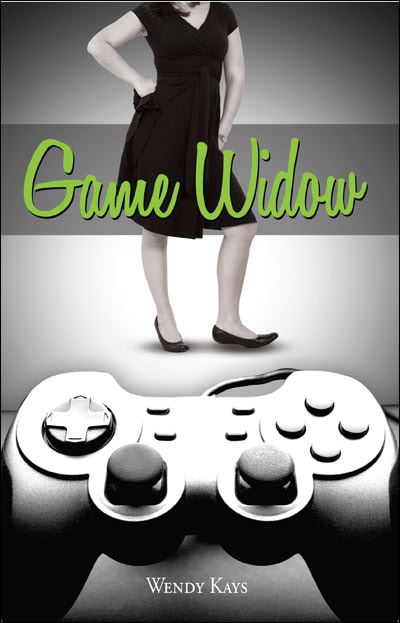 Game Widow by Wendy Kays (Synergy Books, 2008, ISBN 978-1-934454-26-8)
Game Widow by Wendy Kays (Synergy Books, 2008, ISBN 978-1-934454-26-8)
Bonus material available.
This book was written by: Wendy Kays, who “has been married to the lead designer of the SOCOM: U.S. Navy Seals video game series for six years.” Ms. Kays is also a former game widow, but she and her husband have revitalized their once-endangered marriage into a union so strong that his accomplishments are listed first under her biography.
What is in this book: An analysis of the reasons why video games entice so many people to abandon their families, along with a look at the industry that creates them and ways to take back some of the control that they exert over our lives. This is a serious subject because “sending an adult online should have similar expectations that sending an adult to Las Vegas would,” which means that there is a real possibility that some people “will get into trouble of the mild kind, usually, and on occasion, the serious, life-altering or life-ending kind”(p.108).
In the real world, “there’s no road map with big goals broken into smaller goals that have guaranteed rewards for success”(p.8), while the virtual world can be quite rewarding, as Ms. Kays illustrates with Navarre--a fictional online persona created to demonstrate her point. “The Rare Hummingbird of Flashiness that hovers around Navarre is not only pretty and attention-grabbing, it’s [sic] presence also advertises that Navarre is one of only a few players ever to defeat the Elusive Swamp Witch, who only appears in the game once a year”(p.8). Even games designed to mimic reality are streamlined and more pleasant. “You may have to pick up dog poop in the real world, but you don’t have to clean up after your virtual pet. Or if you do, you’re insulated from experiencing the unpleasantness of bending over, fooling with the bag, inhaling the smell, and feeling the warm lump”(p.11).
What is not in this book: A chicken-livered lack of resolve. When their marriage was in trouble, Ms. Kays and her husband “felt a professional was too scary and formal, so we did what we could on our own”(p.79), which meant doing things the hard way. Ms. Kays writes that “I forced myself to listen,” but more importantly she let him talk and “continued to listen (which was extremely difficult, because I wanted to talk about me so badly)”(p.79). Despite the difficulties, Ms. Kays refused to give up. “I even had to swallow my pride and let him take the lead sometimes so he could know this was a joint effort he was part of and not just me acting like a dictator making all the new rules”(p.81).
But she had to go beyond swallowing her pride. “I made a personal rule that I couldn’t talk about him as the problem, just the problem itself. I pretended our problems had magically appeared out of thin air – with no one to blame”(p.80). It got worse for her, because “If he said I was the problem, I had to suck it up and apologize, even if I didn’t feel like I was the problem”(p.80), but it was necessary because anything else would make him think “a ‘fixing things’ talk was really a ‘wife getting time to yell at him’ trick”(p.80).
Game Widow recounts a moving story of intense personal struggle, and Ms. Kays herself writes that “humble pie was expensive emotionally, but I was willing to give up my righteous anger to get my happy life with my husband back”(p.81). It ultimately paid off because not only is their marriage restored, but “in the time my husband used to play video games at night, he is earning an MBA from a prestigious university”(p.115).
Would you recommend this book to widows of U.S. servicemen who were killed in Iraq or Afghanistan? Without reservation. Ms. Kays’ description of a game widow as “a woman whose husband might as well be dead to her because he is constantly engaged with video games”(p.xii) is as respectful to their situation as it is similar. The fact that Ms. Kays’ not-dead husband has earned a living by sensationalizing the ongoing sacrifices made by the United States Armed Forces and marketing it as entertainment can only add another layer of empathy and understanding.
Would you recommend this book to literary agents like Jeanne Fredericks or Robert E. Shepard? Yes, but not just so they can cry bitter tears into their pillows over not signing this author while they had a chance.
It turns out that “the video game industry is not like the book industry in which near-finished manuscripts submitted by eager authors can be reviewed and the best one chosen”(p.41). That means that these agents may find that their unconventional willingness to consider book proposals without reviewing near-finished manuscripts is an attitude better suited for a different field. Someone should also tell Hart Publishing that they can cut their instructions on submitting manuscripts that are not yet written and just wait for the near-finished ones to come rolling in.
Changing trades from publishing books to publishing video games would require some serious adjustments, though. With electronic entertainment, “even if the idea comes from someone who has already designed a best-selling video game, there is no guarantee on how the final product will turn out,”(p.41) which is completely unlike the publishing industry, where bestselling authors can always be relied upon to deliver stellar work.
What was interesting about this book? Ms. Kays’ startlingly plausible extrapolation of future trends based on current evidence. Gaming will cause problems in the workplace because “employers are already considering passing more of the cost of health care on to employees who are overweight or who are smokers. When and if playing video games is shown to make health conditions worse, or even cause them, gamers will be targeted as well”(p.61). In fact, “It’s only a matter of time before organized research into the health effects of video gaming is done and before the debate over who covers the costs of the health consequences of gaming begins,” and in the future “it may become as acceptable to discriminate against gamers as it is to discriminate against smokers and people who are overweight”(p.61).
However, there is still hope. After all, “if society can embrace recycling and alternate energy to impact the environment, sacrifice buying frills to save money for retirement, and avoid buying products from companies known to employ inhumane sweatshops, we can certainly sacrifice some time to carefully choose and manage our entertainment,” which will be how we can “turn the vast tide of a selfish and entitled society and an entrenched game industry”(p.116).






